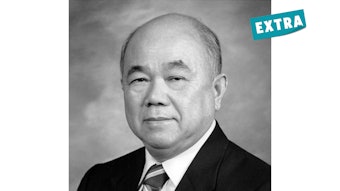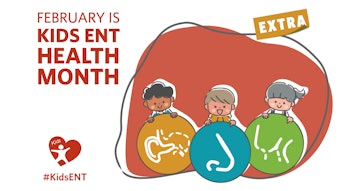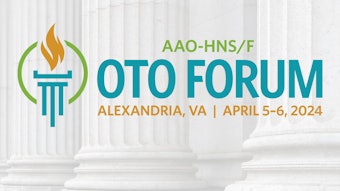Pediatric Rhinitis and Chronic Rhinosinusitis
Treatment of pediatric rhinitis and CRS requires a stepwise approach to diagnosis and management.
Amanda L. Stapleton, MD

The first question an otolaryngologist should ask themselves is, “are all runny noses CRS?” Making the correct diagnosis is the first step to treating pediatric rhinitis patients effectively. Rhinitis is defined as “inflammation and swelling of the mucous membrane of the nose, classified based on duration of symptoms.”1 In contrast, pediatric CRS is defined as, “two or more of following [symptoms], one of which is: nasal blockage/obstruction/congestion or discharge: facial pain/pressure, cough, changes on endoscopy, and changes on CT consistent with chronic sinusitis.” These symptoms must be present for >12 weeks with no symptom-free intervals. As most clinicians know, it can be hard to get an accurate history from parents that meet the criteria of 12 weeks of the above symptoms with no symptom-free intervals. Acute rhinosinusitis is diagnosed when acute symptoms resolve in less than four weeks. Recurrent acute rhinosinusitis is defined as four episodes of acute rhinosinusitis in one year with symptom-free intervals in between.
Parents often describe recurrent episodes of rhinorrhea, chronic congestion, intermittent cough, and occasional antibiotic treatment throughout a 12-week period. So, what is the diagnosis? Is it recurrent viral upper respiratory tract infections, allergic rhinitis symptoms, adenoiditis, or CRS? Taking a stepwise approach to diagnosis can help delineate the underlying driver of disease.
The age of the patient is the most important first data point in the medical decision-making tree. Pediatric patients under five years with symptoms of intermittent rhinorrhea, thick purulent drainage, and cough should be evaluated for recurrent viral upper respiratory infections, adenoiditis, and rhinitis first. The sinonasal development of a young child is incomplete. The aeration of the sinuses progresses from birth through puberty. Therefore, young pediatric patients likely do not have “true” sinusitis as their sinonasal cavities are still underdeveloped. The symptoms they are having are rhinitis episodes and, in some cases, adenoiditis episodes. Physical exam and nasal endoscopy can help guide diagnosis. Purulent nasal drainage, inflamed nasal mucosa, and edematous adenoid tissue with purulent secretions indicate that adenoid infection or biofilm colonization may be a contributing cause. Prior studies have evaluated the role of adenoid lymph tissue as a source of chronic rhinitis and adenoiditis in children.2
Otolaryngologists have targeted adenoid tissue and the biofilm that can often be adherent to it, owing to past studies showing colonization and infection in pediatric patients with CRS.3,4,5,6 Using next-generation 16SrRNA-sequencing techniques, Stapleton et al.7 showed that the microbiota of the nasal cavity and nasopharynx (adenoid tissue) are diverse and different ecologic sites even though they are adjacent anatomic locations. They have distinct microbiologic communities. The nasopharynx was a more microbiologically diverse site with biofilm forming bacteria dominated by: Fusobacterium, Prevotella, Porphyromonas, and Campylobacter. In contrast, the nasal cavity was dominated by Moraxella as the predominant organism. Importantly, pediatric patients’ microbiologic diversity increased with age and medications taken changed the diversity of the sinonasal community.
Identifying concomitant allergic rhinitis is another important step in management. Pediatric allergic rhinitis prevalence increases as children get older. The incidence of allergic rhinitis in six to seven-year-old patients is 8.5% and 14.6% in 13 to 14-year-old patients.8
Culture-directed therapy is also an option for pediatric patients with acute or chronic rhinitis. A recent double-blinded randomized multicenter study randomized 2 to 11-year olds with acute sinusitis to amoxicillin/clavulanic acid versus placebo and followed them for symptom resolution.9 Over 500 pediatric patients had nasopharyngeal culture swabs performed before starting the treatment drug. The study found that those that grew Streptococcus pnuemoniae, Moraxella catarrhalis, or Haemophilus influenzae responded sooner and had earlier symptom resolution than those with no growth on culture.
As children grow older and continue to have rhinitis symptoms that meet criteria for CRS, workup and medical management are essential first steps in their care. A complete history, including allergic and asthmatic disease, can help clue the otolaryngologist into what additional comorbid etiologies are driving sinonasal disease. Physical exams in children should also include nasal endoscopy. The majority of pediatric patients tolerate nasal endoscopy, and it can be done in the office. Identifying diseased mucosa, purulent drainage from the middle meatus, nasal polyps, adenoid hypertrophy, or other sinonasal pathology can change the treatment course.
Initiation of medical therapy and addressing underlying atopic or inflammatory disease are often the first steps. There are several medical options available. Some treatment options have higher levels of evidence of benefit than others. Each patient is different and sometimes different combinations of medical therapies may achieve a satisfactory outcome in the patient. The chart below details the common medical therapies and the recommendations from the American Academy of Otolaryngology–Head and Neck Surgery Foundation “Clinical Consensus Statement: Pediatric Chronic Rhinosinusitis”10 and the “European Position Statement on Rhinosinusitis and Nasal Polyps” (2020).11

The recent U.S. Food and Drug Administration (FDA) approval and use of biologic medications in patients >18 years old with CRS with nasal polyps has spurred interest surrounding its possible use in pediatric patients. There is also a new interest in “endotyping” chronic sinusitis. Endotypes are subtypes of chronic sinusitis defined by their inflammatory biomarkers/pathways. Dupilumab (anti IL-4 and IL- 13 receptor blocker), omalizumab (anti IgE), mepolizumab (anti IL-5), are FDA approved in adults with CRS with nasal polyposis. Dupilumab had the highest nasal polyp reduction score in randomized trials.12 Fortunately for our pediatric patients, Dupilumab is FDA approved for atopic dermatitis treatment in children >6 months old, eosinophilic asthma in those >6 years old, and eosinophilic esophagitis in >1-year olds. Therefore, some pediatric patients with CRS may meet FDA criteria to start dupilumab for another diagnosis and be placed on the biologic medication. Future studies will show whether there is a substantial benefit of biologic use in pediatric CRS.
If medical management fails, then CT imaging can help guide the clinician to identify any anatomic abnormalities within the sinonasal cavity and evidence of CRS. CT imaging should be performed at the completion of maximal medical management to ensure that overdiagnosis of opacification of the sinuses is not being made. This is particularly important as surgical planning is often based on the imaging results.
If medical management fails, then endoscopic sinus surgery is an effective and safe tool to offer patients. Adenoidectomy should be performed first in small children (< 7 years old). Endoscopic sinus surgery in pediatric patients is well tolerated and effective in those that have failed adenoidectomy and/or have CT evidence of chronic disease after medical management. The extent of endoscopic sinus surgery in children should be based on their CT imaging and anatomy. Surgical outcomes are over 90% effective in treating pediatric chronic sinusitis.13,14 Postoperative debridement is often not required if the patient does not have underlying cystic fibrosis or primary ciliary dyskinesia.
Overall, treatment of pediatric rhinitis and CRS requires a stepwise approach to diagnosis and management. Age, atopy, exposure to viruses, sinonasal anatomic development, and microbiologic dysbiosis all contribute to the variability in presentation and response to treatment in this patient cohort. Medical therapies are effective in many patients and endoscopic sinus surgery continues to be a reliable surgical intervention for those that fail medical management. Research into the field of sinonasal microbiome, CRS endotyping, and biologic management of pediatric CRS holds promise that patient-specific diagnostics and management options are on the horizon for these patients.
References
- Fried, Marvin P. “Rhinitis.” Merck Manual Consumer Version. July 2023. https://www.merckmanuals.com/home/ear,-nose,-and-throat-disorders/nose-and-sinus-disorders/rhinitis
- Fokkens, Wytske J., Valerie J. Lund, Joachim Mullol, Claus Bachert, Isam Alobid, Fuad Baroody, Noam Cohen et al. "EPOS 2012: European position paper on rhinosinusitis and nasal polyps 2012. A summary for otorhinolaryngologists." Rhinology 50, no. 1 (2012): 1-12.
- Lee, Dennis, and Richard M. Rosenfeld. “Adenoid Bacteriology and Sinonasal Symptoms in Children.” Otolaryngology–Head and Neck Surgery 116, no. 3 (1997): 301–7. https://doi.org/10.1016/s0194-59989770264-x.
- Talaat, A. M., Y. S. Bahgat, E. El-Ghazzawy, and S. Elwany. “Nasopharyngeal Bacterial Flora before and after Adenoidectomy.” The Journal of Laryngology & Otology 103, no. 4 (1989): 372–74. https://doi.org/10.1017/s0022215100108990.
- Shin, Kwang Soo, Seok Hyun Cho, Kyung Rae Kim, Kyung Tae, Seung Hwan Lee, Chul Won Park, and Jin Hyeok Jeong. “The Role of Adenoids in Pediatric Rhinosinusitis.” International Journal of Pediatric Otorhinolaryngology 72, no. 11 (2008): 1643–50. https://doi.org/10.1016/j.ijporl.2008.07.016.
- Coticchia, James, Giancarlo Zuliani, Crystal Coleman, Michael Carron, Jose Gurrola, Michael Haupert, and Richard Berk. “Biofilm Surface Area in the Pediatric Nasopharynx.” Archives of Otolaryngology–Head & Neck Surgery 133, no. 2 (2007): 110. https://doi.org/10.1001/archotol.133.2.110.
- Stapleton, Amanda L., Amber D. Shaffer, Alison Morris, Kelvin Li, Adam Fitch, and Barbara A. Methé. “The Microbiome of Pediatric Patients with Chronic Rhinosinusitis.” International Forum of Allergy & Rhinology 11, no. 1 (2020): 31–39. https://doi.org/10.1002/alr.22597.
- Wise, Sarah K., Cecelia Damask, Lauren T. Roland, Charles Ebert, Joshua M. Levy, Sandra Lin, Amber Luong et al. "International consensus statement on allergy and rhinology: Allergic rhinitis–2023." International Forum of Allergy & Rhinology 13, no. 4, pp. 293-859. 2023.
- Shaikh, Nader, Alejandro Hoberman, Timothy R Shope, Jong-Hyeon Jeong, Marcia Kurs-Lasky, Judith M Martin, Sonika Bhatnagar, et al. “Identifying Children Likely to Benefit from Antibiotics for Acute Sinusitis: A Randomized Clinical Trial.” JAMA 330, no. 4 (2023): 349–58. https://doi.org/10.1001/jama.2023.10854.
- Brietzke, Scott E., Jennifer J. Shin, Sukgi Choi, Jivianne T. Lee, Sanjay R. Parikh, Maria Pena, Jeremy D. Prager, et al. “Clinical Consensus Statement: Pediatric Chronic Rhinosinusitis.” Otolaryngology–Head and Neck Surgery 151, no. 4 (2014): 542–53. https://doi.org/10.1177/0194599814549302.
- Fokkens WJ, Lund VJ, Hopkins C, et al. European Position Statement on Rhinosinusitis and Nasal Polyps 2020. Rhinology. 2020; Feb 20;58 (Suppl S29):1-464.
- Wu, Qingwu, Yana Zhang, Weifeng Kong, Xinyue Wang, Lianxiong Yuan, Rui Zheng, Huijun Qiu, Xuekun Huang, and Qintai Yang. “Which Is the Best Biologic for Nasal Polyps: Dupilumab, Omalizumab, or Mepolizumab? A Network Meta-Analysis.” International Archives of Allergy and Immunology 183, no. 3 (2021): 279–88. https://doi.org/10.1159/000519228.
- Vlastarakos, Petros V., Melpomeni Fetta, John V. Segas, Pavlos Maragoudakis, and Thomas P. Nikolopoulos. “Functional Endoscopic Sinus Surgery Improves Sinus-Related Symptoms and Quality of Life in Children with Chronic Rhinosinusitis.” Clinical Pediatrics 52, no. 12 (2013): 1091–97. https://doi.org/10.1177/0009922813506489.
- Makary, Chadi A., and Hassan H. Ramadan. “The Role of Sinus Surgery in Children.” The Laryngoscope 123, no. 6 (2013): 1348–52. https://doi.org/10.1002/lary.23961.




















